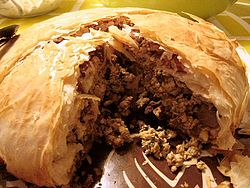بسطیلیہ
 | |
| متبادل نام | Bastilla, Basṭīla, R’zeema, Tajik, Malsouka |
|---|---|
| قسم | Meat pie |
| علاقہ یا ریاست | المغرب العربی |
| قومی پکوان منسلک از | |
| بنیادی اجزائے ترکیبی | Warka dough, broth، مصالحہs; squab، مرغی, fish or offal |
بسطیلیہ (انگریزی: Pastilla) (عربی: بسطيلة) مغربی کھانوں میں ایک گوشت یا سمندری غذا پائی ہے جو ورقہ (آٹا) کے ساتھ بنائی جاتی ہے، جو فیلو کی طرح ہے۔ یہ المغرب، الجزائر، [1][a][3][4] اور تونس کی خصوصیت ہے، جہاں اسے ملسوقہ بھی کہا جاتا ہے۔ [5]:1190[6] یہ حال ہی میں مہاجرین کے ذریعے فرانس، اسرائیل اور شمالی امریکا میں پھیلا ہے۔
مزید دیکھیے
حوالہ جات
- ↑ انتباہ حوالہ:
Albala2011کے نام کے حامل<ref>ٹیگ کی نمائش نہیں دیکھی جا سکتی کیونکہ اسے یا تو اس قطعہ سے باہر کسی اور جگہ رکھا گیا ہے یا سرے سے رکھا ہی نہیں گیا۔ - ↑ Anny Gaul (27 نومبر 2019)۔ "Bastila and the Archives of Unwritten Things"۔ Maydan۔ اخذ شدہ بتاریخ 2019-12-13
- ↑ "Migrations" (PDF)۔ www.hommes-et-migrations.fr۔ 2019-04-12 کو اصل (PDF) سے آرکائیو کیا گیا
- ↑ Bouksani, Louisa (1989). Gastronomie Algérienne. Alger, Ed. Jefal. p. 150
- ↑ انتباہ حوالہ:
Gil Marksکے نام کے حامل<ref>ٹیگ کی نمائش نہیں دیکھی جا سکتی کیونکہ اسے یا تو اس قطعہ سے باہر کسی اور جگہ رکھا گیا ہے یا سرے سے رکھا ہی نہیں گیا۔ - ↑ "TAJIK-PASTILLA BÔNOISE PIGEONS ET NOIX". Cuisine Bonoîse de Zika (بزبان فرانسیسی). 11 Feb 2020. Retrieved 2023-04-05.
حوالہ جات کی نمائش
- ↑ I was especially interested in Tetouani baqlawa, a pastry typically associated with the eastern Mediterranean, not the west. The baqlawa we sampled was shaped in a spiral, unlike the diamond-shaped version I was more familiar with from Levantine food. But its texture and flavors––thin buttered layers of crisp papery pastry that crunch around sweet fillings with honeyed nuts––were unmistakable. Instead of the pistachios common in eastern baqlawa, El Mofaddal's version was topped with toasted slivered almonds. Was baqlawa the vehicle that had introduced phyllo dough to Morocco? [...] There is a strong argument for the Turkic origin of phyllo pastry, and the technique of shaping buttered layers of it around sweet and nut-based fillings was likely developed in the imperial kitchens of Istanbul. So my next step was to find a likely trajectory that phyllo dough might have taken from Ottoman lands to the kitchens of northern Morocco. [...] It so happened that one of Dr. Bejjit's colleagues, historian Idriss Bouhlila, had recently published a book about the migration of Algerians to Tetouan in the nineteenth/thirteenth century. His work explains how waves of Algerians migrated to Tetouan fleeing the violence of the 1830 French invasion. It includes a chapter that traces the influences of Ottoman Algerians on the city's cultural and social life. Turkish language and culture infused northern Morocco with new words, sartorial items, and consumption habits––including the custom of drinking coffee and a number of foods, especially sweets like baqlawa. While Bouhlila acknowledges that most Tetouanis consider bastila to be Andalusi, he suggests that the word itself is of Turkish origin and arrived with the Algerians." [...] "Bouhlila's study corroborated the theory that the paper-thin ouarka used to make bastila, as well as the name of the dish itself, were introduced to Morocco by way of Tetouani cuisine sometime after 1830."[2]